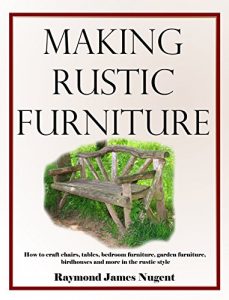This book of rustic woodworking offers superb, illustrated guidance to building furniture, decorations and structures in the rustic style.
Upon its pages are a range of illustrated rustic projects, with clear descriptions capably instructing absolute beginners and experienced woodworkers alike on how to build rustic furniture. In addition, detailed guidance on the tools and kinds of wood to use in the craft is also imparted. Followed closely, these instructions will ensure furniture of a thoroughly decent quality that will last for years.
Authored by career woodworker and furniture maker Raymond James Nugent, this book's instructions and pages are imbued with experience accrued over years of fashioning fine furnishings from gathered logs and branches.
We begin this book with the very basics; this light rustic work is what you should practice at the outset – the jointing and fastening of wooden parts essential for rustic woodwork are detailed. Simpler constructions, such as flower stands and vases, follow before the core chapters – those concerning interior and garden furnishings – commence. The most popular forms of seating, as well as tables suited for indoor or outdoor use, all have dedicated parts. What’s more, every single design discussed has at least one detailed illustration showing its exact schematics.
By the end of this guidebook, you not only have made and mastered a number of the instructions here, but are inspired to create your own elaborations and designs. A salient point to note is that you can opt for different woods and append your own flourishes and additions, as you see fit. While a signature style is something crafters of all kinds spend years honing, it is hoped that this primer will set you on a long path to achieving such a thing.
Having regained prominence in recent years after decades of made-to-order furnishings churned from huge factories, the rustic style is at the forefront of a revival. Being as the last great eruption of rustic style was during The Great Depression, it may be appropriate that The Great Recession of the present day should herald new and sustained interest.
There is a notable backlash against the endlessly similar furniture templates which so commonly grace the modern home, which only a return to the personally crafted past can remedy. Many homeowners regardless of age or background wish to truly make a place their own by adding homemade furnishings to it. What better a place to start stamping a real, material identity on a place than crafting a simple flower stand, a chair, or a garden table created from the finest samples of hazel, yew or birch wood?
Many a person, particularly during the summer months, relishes the opportunity to sit outside and assemble their very own creation made from wood. You needn’t be a rugged outdoorsman, a master carpenter or seasoned woodworker to embark on such a hobby; the most important ingredient in your success is enthusiasm. The money spent to start needn’t be a concern; expensive treatments or tools are few when we compare rustic against conventional means of furniture making. Assembly can take place either in a garage, made-for-purpose shed, or even outdoors with the tools and materials laid out around you.






